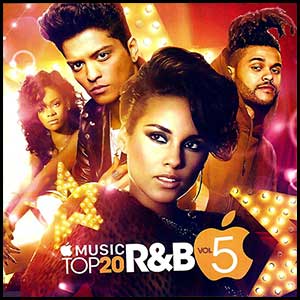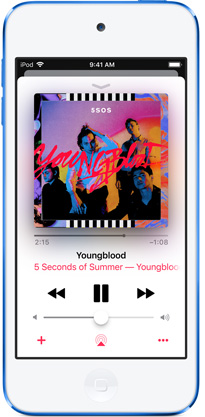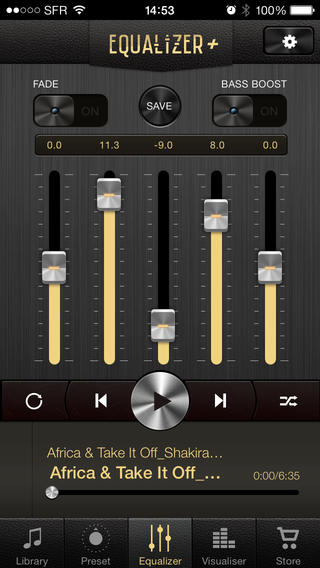

- #Apple music ivolume upgrade#
- #Apple music ivolume android#
- #Apple music ivolume download#
- #Apple music ivolume free#
You can also Shift-click multiple songs and then select Download from the right-click menu. Now that you've deleted the DRM-protected music, you should now see the option to re-download them from iCloud using the icon highlighted above. Click the cloud icon in the attribute bar to sort the songs by iCloud. Next to the songs you just deleted, you should now see a small cloud icon has been added to the right of the song names. When they’ve been deleted, empty the Trash. If asked, choose to move the songs to the Trash.Īfter your music has been matched, you can delete the DRM-protected songs, but don't check the box to delete them from iCloud. Next, press Fn Delete to remove the protected songs from your library. Highlight all of the Protected AAC music by clicking the first song and then, while holding Shift, clicking the last song in the list. Once your music has been matched successfully, return to your iTunes library sorted by Kind.

Tip: The iTunes Match service checks your iTunes balance before charging your credit card so if the charge doesn’t come to an even $25, it’s likely because part of the cost was covered by existing funds in your account.

If a large portion of your library is unique (one-off) music, you may want to move to the fastest internet you can find for Step 3 of iTunes Match, when music that isn't in the iTunes store is uploaded song-by-song. Of the 1878 songs I had, 1600-plus were matched quickly, while the remainder needed to be uploaded to iCloud since they were specialty tracks or were improperly named. The process is fairly swift, though the speed of the matching process relies on your music library size/origins and your Internet speed. To start the iTunes Match service, click Turn On iTunes MatchStore menu. When you’ve accepted the charges, iTunes will begin matching your music. iTunes will confirm that you want to pay the $25 fee before continuing. To turn on iTunes match, select Store > Turn On iTunes Match from the iTunes menubar. These are the tracks with DRM protection. Scrolling through your listing, you should see a number of songs with Protected AAC audio file listed as the file kind. The fastest way to identify the DRM-protected music is sorting by file kind, but first you need to turn that criterion on in the options.Įxit the dialog box, and then click Kind in the header area of your music library to sort the songs accordingly. Click View > Show View Options and put a tick next to Kind under the File subheading of the dialog box. To find your DRM-laden tracks, you need to add Kind as an attribute. The newest version of iTunes has removed some of the song attributes from the library area so the method for sorting your music beyond artist or album isn’t immediately evident. This can be done by dragging the iTunes folder from your Mac’s Music folder to the backup drive.

Step 1: Back It Upīefore you begin, back up your current music library to an external hard drive or USB drive. The service is $25/year, but you should only have to do this process once as iTunes music purchased from 2009-on no longer has DRM protection. With the introduction of iTunes Match, a service that creates 1-for-1 copies of your iTunes library in the cloud, removing DRM from your music is easier than ever. Depending on the amount of protected music you have, that could be a costly venture.Ī less-costly, but time-intensive way to strip the DRM is to burn all of the protected music to CDs, delete the protected versions, and then re-import the songs from the burned disc.
#Apple music ivolume upgrade#
When Apple began removing DRM from its library of songs in 2009, it offered users the ability to pay $.30 per song to upgrade from the protected song to a better quality 256-kbps version without DRM protection. In short, it aggressively limits the flexibility of the music you purchased.Īfter sorting your music by file kind, look for the phrase "Protected AAC audio file" to indicate a track has Digital Rights Management (DRM).
#Apple music ivolume android#
You cannot upload a protected song or album to Amazon Cloud Player or Google Play Music, play the song on an Android device, or move the song to a new computer without authorizing that computer with your iTunes account. Step outside of Apple TVs, iPhones, and iPods, though, and its annoyance quickly becomes evident. If you’re used to keeping your media and digital life within Apple’s ecosystem, you may have never noticed the impact of DRM. In this tutorial, I’ll provide an inexpensive workaround that makes stripping DRM easy by employing Apple's iTunes Match service.
#Apple music ivolume free#
Now that DRM for music is largely a thing of the past, how can you cost-effectively free your music from Apple’s Fair Play protection? In the heyday of illegal music-sharing services, iTunes was a beacon of light to the recording industry because Apple's service incorporated Digital Rights Management (DRM) to discourage piracy.


 0 kommentar(er)
0 kommentar(er)
